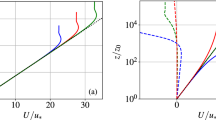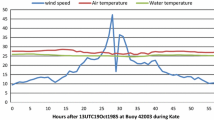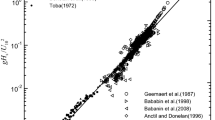Abstract
A model for the air–sea interface, based on the coupled pair of similarity relations for “aerodynamically” rough flow in both fluids, is presented, which is applied to fetch-limited and high wind speed conditions which occur, for example, in hurricanes. It is shown that the specification of the maximum 10-m drag coefficient and the 10-m wind speed and the peak wave speed at which it occurs are sufficient to uniquely determine the drag law, which asymptotes at low wind speeds to a Charnock constant similar to that for the fully developed wind wave sea and is almost independent of the peak wave speed at the maximum in drag coefficient. A feature of the drag law is that it is of Charnock form, almost independent of the wave age, consistent with the transfer of momentum to the wave spectrum being due to the smaller rather than the dominant wavelengths. The analysis is also applied to a variable sea state in which either the surface wind or the surface Stokes drift vary, but the peak wave speed is kept constant. The corresponding variability in the Charnock constant is in general accord with observations.



Similar content being viewed by others
References
Bye JAT (1988) The coupling of wave drift and wind velocity profiles. J Mar Res 46:457–472
Bye JAT, Babanin A (2009) Wave generation by wind. In: Steele JH, Turekian KK, Thorpe SA (eds) Encyclopedia of ocean sciences, 2nd edn. Elsevier, Boston, pp 304–309
Bye JAT, Jenkins AD (2006) Drag coefficient reduction at very high wind speeds. J Geophys Res 111:C03024. doi:10.1029/2005JC003114
Bye JAT, Wolff J-O (2004) Prediction of the drag law for air–sea momentum exchange. Ocean Dyn 54:577–580
Bye JAT, Wolff J-O (2008) Charnock dynamics: a model for the velocity structure in the wave boundary layer of the air–sea interface. Ocean Dyn 58:31–42
Charnock H (1955) Wind stress on a water surface. Q J R Meteorol Soc 81:639–640
Csanady GT (2008) Drag generation mechanisms. In: Jones ISF, Toba Y (eds) Wind stress over the ocean. Cambridge University Press, Cambridge, pp 124–141
Donelan MA (1990) Air–sea interaction. In: Le Mehaute B, Haines DM (eds) The sea: ocean engineering science, vol 9. Wiley, New York, pp 239–292
Donelan MA, Dobson FW, Smith SD, Anderson RJ (1993) On the dependence of sea surface roughness on wave development. J Phys Oceanogr 23:2143–2149
Jarosz E, Mitchell DA, Wang DW, Teague WJ (2007) Bottom-up determination of air-sea momentum exchange under a major tropical cyclone. Science 315:1707–1709
Jones ISF, Toba Y (2008) Wind stress over the ocean, 2nd edn. Cambridge University Press, Cambridge, p 307
Kahma KK, Donelan MA (1988) A laboratory study of the minimum wind speed for wind wave generation. J Fluid Mech 192:339–364
Keller MR, Keller WG, Plant WJ (1992) A wave tank study of the determination of X-band cross sections on wind speed and water temperature. J Geophys Res 97(C4):5771–5792
Mitsuyasu H, Bock EJ (2008) The influence of surface tension. In: Jones ISF, Toba Y (eds) Wind stress over the Ocean. Cambridge University Press, Cambridge, pp 242–253
Powell MD, Vickery PJ, Reinhold TA (2003) Reduced drag coefficient for high wind speeds in tropical cyclones. Nature 422:279–283
Sullivan PP, McWilliams JC (2010) Dynamics of winds and currents coupled to surface waves. Annu Rev Fluid Mech 42:19–42
Toba Y (1973) Local balance in the air-sea boundary process III. On the spectrum of wind waves. J Oceanogr Soc Japan 29:209–220
Toba Y, Jones ISF (2008) The influence of unsteadiness. In: Jones ISF, Toba Y (eds) Wind stress over the ocean. Cambridge University Press, Cambridge, pp 190–205
Toba Y, Smith SD, Ebuchi N (2008) Historical drag expressions. In: Jones ISF, Toba Y (eds) Wind stress over the ocean. Cambridge University Press, Cambridge, pp 35–53
Wu J (1980) Wind-stress coefficients over sea surface near-neutral conditions—a revisit. J Phys Oceanogr 10:727–740
Acknowledgements
This paper was completed while JATB was a visiting researcher at the KlimaCampus of the Universität Hamburg, Germany. The comments of an anonymous reviewer are greatly appreciated.
Author information
Authors and Affiliations
Corresponding author
Additional information
Responsible Editor: Dirk Olbers
Appendix
Appendix
1.1 A The dependence of c 0 on R 0 (or alternatively a or B)
We seek first to express a and B in terms of R 0. On eliminating \(\hat c_0\) between Eqs. 22 and 15 applied at \(\hat K_{10}\) and using Eq. 17, we obtain
and on eliminating \(\hat c_0\) between Eqs. 22 and 29, we have
Hence, from Eq. 15,
and on substituting Eq. 46 in Eq. 12, K 10(u ⋆ , R 0).
In summary for a prescribed R 0, the peak wave speed c 0 and also K 10 are both only functions of u ⋆ (or u 10). We note also that Eq. 44 reduces approximately to \(a \approx 2/(\hat u_\star \kappa R_0)\), and since all the estimates of \(\hat u_{10}\) are similar, a is approximately inversely proportional to R 0 (Table 1). The range of R 0, however, is not large, and hence, the dependencies of α on u ⋆ are similar from Eq. 23 for a prescribed α 0, and consequently, the drag laws are also similar.
Rights and permissions
About this article
Cite this article
Bye, J.A.T., Ghantous, M. & Wolff, JO. On the variability of the Charnock constant and the functional dependence of the drag coefficient on wind speed. Ocean Dynamics 60, 851–860 (2010). https://doi.org/10.1007/s10236-010-0300-8
Received:
Accepted:
Published:
Issue Date:
DOI: https://doi.org/10.1007/s10236-010-0300-8




